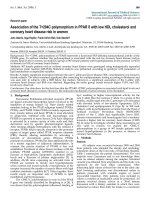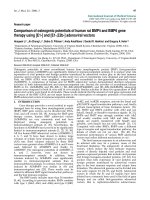Báo cáo y học: "Human toxoplasmosis and the role of veterinary clinicians"
Bạn đang xem bản rút gọn của tài liệu. Xem và tải ngay bản đầy đủ của tài liệu tại đây (128.64 KB, 2 trang )
Int. J. Med. Sci. 2009, 6
133
I
I
n
n
t
t
e
e
r
r
n
n
a
a
t
t
i
i
o
o
n
n
a
a
l
l
J
J
o
o
u
u
r
r
n
n
a
a
l
l
o
o
f
f
M
M
e
e
d
d
i
i
c
c
a
a
l
l
S
S
c
c
i
i
e
e
n
n
c
c
e
e
s
s
2009; 6(3):133-134
© Ivyspring International Publisher. All rights reserved
Short Communication
Human toxoplasmosis and the role of veterinary clinicians
Laura Kramer
Department of Animal Health- Veterinary Parasitology Laboratory- University of Parma,Parma (Italy)
Published: 2009.03.19
Human toxoplasmosis is one of the most com-
mon parasitic zoonoses worldwide. As for other
zoonoses, veterinarians play an important role in the
education of the human population regarding the risk
of infection. Knowledge of the parasite’s biological
charateristics, life cycle and trasmission routes is nec-
essary to correctly illustrate real risk factors to those
people who have direct contact with animals (farm
animals, pets, etc).
Toxoplasmosis represents one of the more diffi-
cult “educational” challenges for small animal clini-
cians. Veterinarians are often faced with the need to
explain to their clients that it is not necessary, for
example, to give away one’s cat during pregnancy
and that if they follow a few very simple “rules”, liv-
ing with their pets need not represent any risk for
infection with Toxoplasma gondii.
Cats are the definitive host of T. gondii; they are
the only animals that pass oocysts in their feces. They
become infected by eating infected rodents, birds, or
other small animals. Once oocysts are shed, they re-
quire 1 to 5 days to sporulate and become infective.
Cats pass oocysts for only 2 to 3 weeks following
primary infection. Mature cats are less likely to shed
Toxoplasma if they have been previously infected.
Litter box hygiene is the main precaution in
preventing transmission of toxoplasmosis from pet
cats [1]. A Toxoplasma-infected cat that is shedding the
parasite in its feces (approximately 2% of the cat
population at any given time) contaminates the litter
box. If the cat is allowed outside, it can contaminate
the soil or water in the environment as well. Litter
boxes should be cleaned daily and not placed in
kitchen or dining areas. Pregnant women should
avoid changing cat litter if possible. If no one else can
perform the task, they should wear disposable gloves
and wash their hands thoroughly with soap and wa-
ter afterwards. Direct contact with cats is unlikely to
result in transmission of toxoplasmosis because
most cats do not leave feces on their fur for the 1 to 5
days required for oocyst sporulation. Interestingly,
cat ownership has not been associated with an in-
crease in Toxoplasma seroconversion among
HIV-infected persons [2].
Along with their pregnant owners, cats should
also avoid becoming infected with T. gondii. There-
fore, cats should not be allowed to hunt and should
not be fed raw or undercooked meat. This is ex-
tremely important, in that raw or undercooked meat
is one of the most common routes of transmission for
T. gondii, for both humans and animals [3]. Pregnant
women at risk must not only avoid eating raw meat,
but should also wash their hands thouroughly after
handling it.
Because outdoor cats frequently defecate in
gardens and T. gondii oocysts may survive for months
under appropriate conditions, pregnant women
should wear gloves when gardening or working with
soil and should immediately wash their hands after-
wards. They should also avoid eating unwashed fruits
or vegetables from a garden.
Finally, because young cats more often eliminate
oocysts compared to older cats, pregnant women
should not adopt or handle kittens and should avoid
getting a new cat during pregnancy.
A recent study [4] has shown that communica-
tion between physicians and veterinarians about
zoonotic diseases is largely absent. Enhancing such
communication could help prevent transmission of
zoonotic agents. Links between the professions on a
broader scale (e.g., through combined veteri-
nary/medical student training and continuing educa-
tion) to foster a broader consensus about zoonotic
disease risks and prevention should also be encour-
Int. J. Med. Sci. 2009, 6
134
aged. This is particularly true with regards to T.
gondii, where the consequences of infection can be
very severe, while the risk of living with one’s be-
loved cat is practically nill.
References
1. Angulo FJ, Glaser CA, Juranek DD et al. Caring for pets of
immunocompromised persons. Can Vet J. 1995; 36: 217-222
2. Glaser CA, Angulo FJ, Rooney JA. Animal-associated oppor-
tunistic infections among persons infected with the human
immunodeficiency virus. Clin Infect Dis.1994;18:14-24.
3. Han K, Shin DW, Lee TY, et al. Seroprevalence of Toxoplasma
gondii infection and risk factors associated with seropositivity
of pregnant women in Korea. J Parasitol. 2008; 94: 963-965.
4. Grant S and Olsen CW. Preventing zoonotic diseases in im-
munocompromised persons: the role of physicians and veteri-
narians. Emerg Infect Dis. 1999; 5: 159-163









